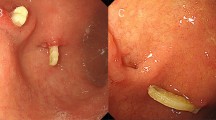Abstract
Current laparoscopic stapling technology still cannot prevent bile leakage (<55%) along the resection margin. A new staple line reinforcement technique was used in the present case. This technique incorporates an absorbable polymer membrane into the stapler system, such that it buttresses the transected solid organ. The objectives of this novel procedure are to decrease hemorrhage at the staple line and to prevent bile duct leakage after liver resection. A 47-year-old man followed for status post biliopancreatic diversion with duodenal switch presented with epigastric pain. On imaging, he was found to have a lesion in segment 2–3 of the left lobe of the liver, which measured at least 3 cm in diameter. He was admitted to the hospital to undergo a laparoscopic left lateral liver resection. This procedure involved laparoscopic ultrasonography of the liver and transection of the left liver lobe with endoscopic linear staplers. The staple height of 3.5, 60 mm long, reinforced with an absorbable polymer membrane was used for liver transection to catch the portal branches. This required multiple firings in the liver parenchyma and additional division of some tissue using the Harmonic scalpel. The larger branch in the middle of segment 2–3 and the left hepatic vein were both transected with the novel staple line reinforcement technique. Bleeding or any bile leakage in this area could not be visualized. No drains were left. The patient’s postoperative course was uncomplicated, and he was discharged on postoperative day 3. Pathology results showed a cavernous hemangioma of 4.5 cm in diameter. Staple line reinforcement with the absorbable polymer membrane has the potential to decrease staple line hemorrhage and bile leakage.
Similar content being viewed by others
References
Montorsi M, Santambrogio R, Bianchi P, et al. Laparoscopy with laparoscopic ultrasound for pretreatment staging of hepatocellular carcinoma: A prospective study. Laparoscopic Ultrasound 2001;5:312–315.
Descottes B, Lachachi F, Durand-Fontanier S, Sodji M, Pech de Laclause B, Valleix D. Traitement laparoscopique des tumeurs solides et kystiques du foie. Étude de 33 cas. Ann Chir 2000;125:941–947.
Kamel IR, Choti MA, Horton KM, et al. Surgically staged focal liver lesions: Accuracy and reproducibility of dual-phase helical CT for detection and characterization. Radiology 2003;227:752–757.
Descottes B, Glineur D, Lachachi F, et al. Laparoscopic liver resection of benign liver tumors. Surg Endosc 2003;17:23–30.
Cherqui D, Husson E, Hammoud R, et al. Laparoscopic liver resections: A feasibility study in 30 patients. Ann Surg 2000; 232:753–762.
Mouiel J, Kathkouda N, Gugenheim J, Fabiani P. Possibilities of laparoscopic liver resection. J Hepatobiliary Pancreat Surg 2000;7:1–8.
Gramática L Jr, Herrera MF, Mercado-Luna A, Sierra M, Verasay G, Brunner N. Videolaparoscopic resection of insulinomas: Experience in two institutions. World J Surg 2002; 26:1297–1300.
Furihata M, Tagaya N, Kubota K. Laparoscopic enucleation of insulinoma in the pancreas. Case report and review of the literature. Surg Laparosc Endosc Percutan Tech 2001;11:279–283.
Fernández-Cruz L, Sáenz A, Astudillo E, et al. Outcome of laparoscopic pancreatic surgery: Endocrine and nonendocrine tumors. World J Surg 2002;26:1057–1065.
Brolin RE. Laboratory evaluation of four techniques of stapled gastroplasty. Surgery 1985;97:66–71.
Katz AR, Mukherjee DP, Kaganov AL, Gordon S. A new synthetic mono.lament absorbable suture made from polytrimethylene carbonate. Surg gynecol obstet 1985;161:213–222.
Bourne RB, Bitar H, Andreae PR, Martin LM, Finlay JB, Marquis F. In-vivo comparison of four absorbable sutures: Vicryl, Dexon Plus, Maxon and PDS. Can J Surg 1988;31:43–45.
Sanz LE, Patterson JA, Kamath R, Willett G, Ahmed SW, Butter.eld AB. Comparison of Maxon suture with Vicryl, chromic catgut, and PDS sutures in fascial closure in rats. Obstet Gynecol 1988;71:418–422.
Metz SA, Chegini N, Masterson BJ. In vivo and in vitro degradation of mono.lament absorbable sutures, PDS and Maxon. Biomaterials 1990;11:41–45.
Kangas J, Paasimaa S, Makela P, et al. Comparison of strength of poly-L/D-lactide (PLDLA) 96/4 and polyglyconate sutures: In vitro, in the subcutis, and in the Achilles tendon of rabbits. Inc J Biomed Mater Res 2001;58:121–126.
Kawamura M, Kase K, Sawafuji M, Watanabe M, Horinouchi H, Kobayashi K. Staple-line reinforcement with a new type of polyglycolic acid felt. Surg Laparosc Endosc Percutan Tech 2001;11:43–46.
Miller JI, Landreneau RJ, Wright CE, Santucci TS, Sammons BH. A comparative study of buttressed versus nonbuttressed staple line in pulmonary resections. Ann Thorac Surg 2001;71:319–322.
Murray KD, Ho CH, Hsia JY, Little AG. The in.uence of pulmonary staple line reinforcement on air leaks. Chest 2002; 122:2146–2149.
Itoh E, Matsuda S, Yamauchi K, et al. Synthetic absorbable film for prevention of air leaks after stapled pulmonary resection. J Biomed Mater Res 2000;53:640–645.
Fischel RJ, McKenna RJ. Bovine pericardium versus bovine collagen to buttress staples for lung reduction operations. Ann Thorac Surg 1998;65:217–219.
Hazelrigg SR, Boley TM, Naunheim KS, et al. Effect of bovine pericardial strips on air leak after stapled pulmonary resection. Ann Thorac Surg 1997;63:1573–1575.
Shikora SA, Kim JJ, Tarnoff ME. Reinforcing gastric staplelines with bovine pericardial strips may decrease the likelihood of gastric leak after laparoscopic Roux-en-Y gastric bypass. Obes Surg 2003;13:37–44.
Chae FH, McIntyre RC, Stiegmann GV. Laparoscopic bariatric surgery. Surg Endosc 1999;13:547–549.
Shamji MF, Maziak DE, Shamji FM, Matzinger FR, Perkins DG. Surgical staple metalloptysis after apical bullectomy: A reaction to bovine pericardium? Ann Thorac Surg 2002; 74:258–261.
Provencher S, Deslauriers J. Late complication of bovine pericardium patches used for lung volume reduction surgery. Eur J Cardiothorac Surg 2003;23:1059–1061.
Ahmed S, Marzouk K, Bhuiya T, Iqbal M, Rossol L. Asymptomatic expectoration of surgical staples complicating lung volume reduction surgery. Chest 2001;119:307–308.
Oey I, Waller D. Metalloptysis: A late complication of lung volume reduction surgery. Ann Thorac Surg 2001;71:1694–1695.
Author information
Authors and Affiliations
Corresponding author
Rights and permissions
About this article
Cite this article
Consten, E.C.J., Gagner, M. Perioperative outcome of laparoscopic left lateral liver resection is improved by using staple line reinforcement technique: A case report. J Gastrointest Surg 9, 360–364 (2005). https://doi.org/10.1016/j.gassur.2004.07.016
Issue Date:
DOI: https://doi.org/10.1016/j.gassur.2004.07.016




